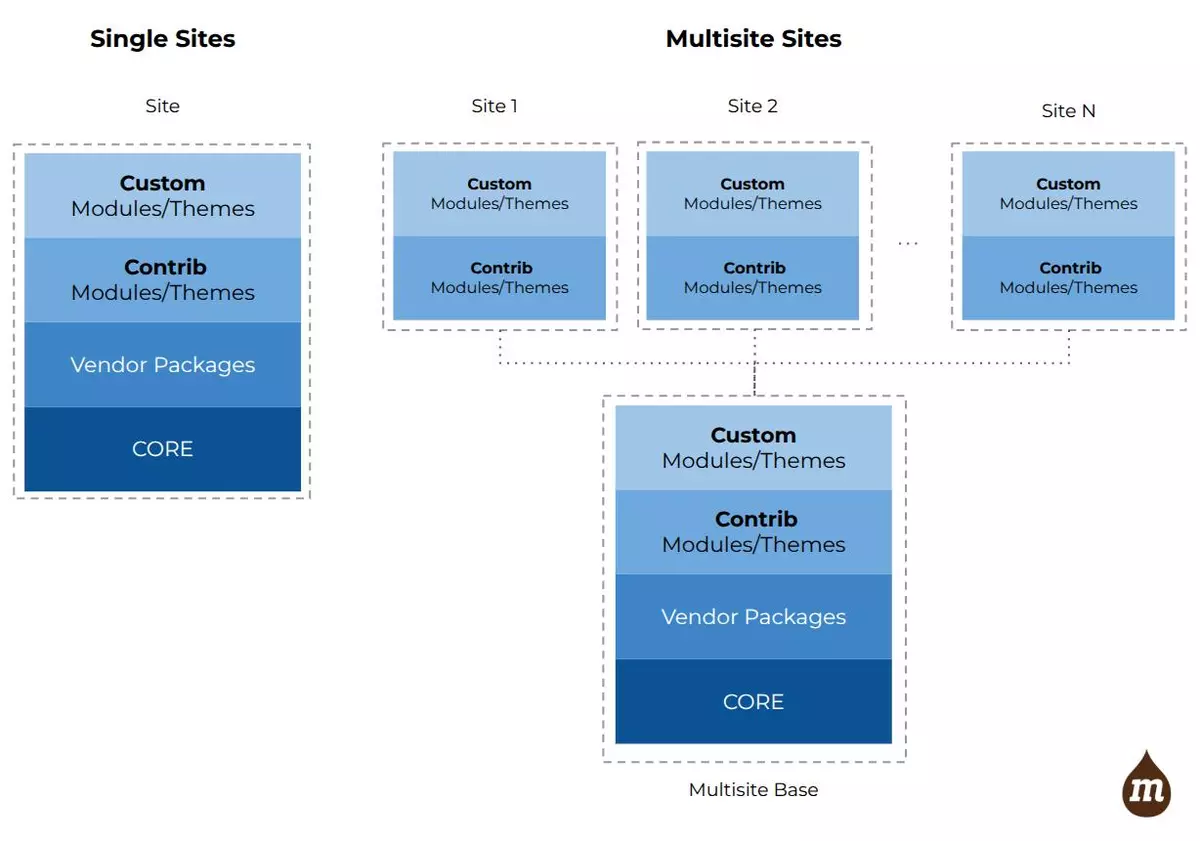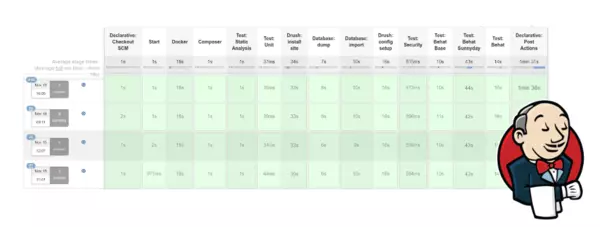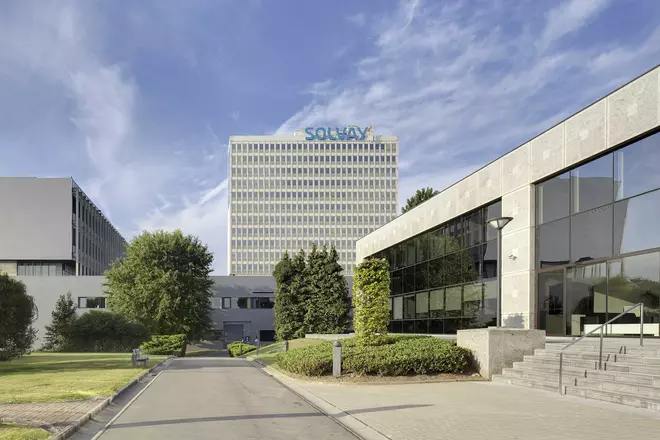Drupal Multisite Solutions: Manage Multiple Websites Efficiently
Unify Your Web Ecosystem with a Scalable Drupal Multisite Architecture
One framework. Multiple sites. Unlimited possibilities.
Whether you're a multinational organization, a university, or a global NGO, managing dozens or hundreds of websites can become chaotic and expensive. We help you regain control with a centralized, secure, and multilingual Drupal multisite platform tailored to your governance and scalability needs.




What Is a Drupal Multisite?
A Drupal Multisite architecture lets you manage multiple independent websites from a single shared codebase, combining efficiency with flexibility.
Each site runs on its own database and configuration, but they all share the same:
- Drupal Core – the stable, security-hardened foundation.
- Contributed Modules – vetted and reusable community-built features.
- Custom Code – business-specific logic developed once, reused everywhere.
- Custom Themes & Design Systems – shared visual language with room for local variation.
Whether you’re managing 5 sites or 500, Drupal Multisite gives you scalability without duplication.

Drupal Mutisite Architecture
Why Choose a Drupal Multisite Architecture?
Our solution enables you to run multiple websites from a single, stable Drupal codebase, offering:
- Centralized Governance: Standardize branding, design systems, modules, and workflows across all your websites.
- Multilingual by Design: Easily manage content in dozens of languages using Drupal’s native i18n features.
- Massive Scalability: Launch new sites in minutes, not weeks, using automated site provisioning pipelines.
- Security & Compliance at Scale: Apply updates and enforce GDPR, WCAG, or HIPAA compliance centrally—across every site.
- Performance Optimized: Shared caching, CDN integrations, and DevOps-friendly configurations.
Full Design Freedom, Flexible Components
Each site in a Drupal multisite setup can have its own theme and visual identity,—to users, they feel like completely separate websites.
Behind the scenes, sites share a common design system and reusable components (headers, footers, layouts, forms). This ensures consistency and speeds up development.
But flexibility is built in:
Each site can
- Use shared components,
- Customize them, or
- Add its own, without affecting the others.
You get centralized control and efficiency, with room for full creative freedom where needed.
Automate Site Creation and Deployment
Scale without friction.
In organizations with large or fast-growing site networks, manual provisioning quickly becomes unsustainable. That’s why we offer:
- Automated site creation pipelines
- CI/CD workflows integrated with multisite logic
- Environment-ready deployments that plug directly into staging, preprod, and production
Our solutions are DevOps-ready and fully customizable.


We have experience integrating Drupal multisite architectures into both enterprise-grade hosting platforms like Acquia Cloud Site Factory (ACSF) and self-hosted environments. Whether you need to leverage the automation, governance, and scalability of ACSF or prefer full control on your own infrastructure, we adapt the multisite setup to your needs, ensuring performance, security, and flexibility in any scenario.
Already Using Drupal? Let’s Take It Further
If you already have a Drupal setup in place, we can help you:
- Stabilize and refactor your current architecture into a robust multisite model.
- Audit and Streamline: Identify duplicated code, performance bottlenecks, or inconsistent editorial workflows.
- Upgrade & Future-Proof: We help you transition to Drupal 10 or 11, cleanly and securely.
- Enforce Standards: Bring all business units into a consistent governance model, while keeping local autonomy where needed.
You don’t need to start over. We evolve what already works.
Frequently Asked Questions: Drupal Multisites
- When should I consider moving to a Drupal multisite setup?
If you're managing multiple websites—for brands, regions, departments, or campaigns—a Drupal multisite allows you to centralize code, streamline maintenance, enforce standards, and scale efficiently. It's ideal when you want both consistency and flexibility across a large web ecosystem. - Can each site look and feel completely different?
Yes. Each site can have its own theme, layout, and design, making them feel like entirely separate websites to end users, even though they share the same backend infrastructure. - Will sites be too dependent on each other? What if one breaks?
Each site runs on its own database and configuration, so issues on one site won’t break the others. Code updates are applied centrally, but we implement proper testing and deployment pipelines to ensure stability across the network. - Can each team or department manage its site independently?
Absolutely. We configure granular permissions, so local teams can manage their own content and users, while central governance teams maintain control over global components, compliance, and design standards. - Can I personalize or extend features for specific sites?
Yes. Shared components can be reused across sites, but each site can also customize or extend functionality without affecting the rest, ensuring flexibility without chaos. - Does it support multilingual and regional content?
Drupal is built for multilingual support. You can manage translations for each site or run dedicated language/country-specific sites with localized content, menus, and features. - Is Drupal multisite scalable for large organizations?
Yes. Drupal multisite is ideal for large-scale ecosystems—from 5 to 500+ sites. We also provide automated site provisioning and DevOps pipelines to keep scaling smoothly and manageably. - What are the hosting options for Drupal multisites?
We work with both enterprise hosting platforms (like Acquia Cloud Site Factory, Platform.sh) and self-hosted infrastructures. We’ll help you choose the best option based on control, security, and scalability needs. - What’s the cost advantage of using a multisite architecture?
You avoid duplicate development and reduce ongoing maintenance by centralizing updates, features, and design. It’s more cost-effective than managing isolated sites and accelerates your time to market. - Can you help us transition from a non-multisite Drupal setup?
Yes. If you already use Drupal, we can help consolidate your current sites into a clean multisite architecture, improve governance, refactor shared components, and enhance long-term maintainability.
Let’s Build Your Multisite Platform
Whether you're starting fresh, scaling up, or refactoring your current Drupal network, we’re here to architect a solution that grows with your organization.
Schedule a free consultation
We’ll review your current stack, pain points, and goals, then propose the ideal Drupal multisite approach for your context.



